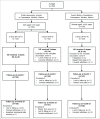Evaluation of the immunogenicity of the quadrivalent HPV vaccine using 2 versus 3 doses at month 21: An epidemiological surveillance mechanism for alternate vaccination schemes
- PMID: 26211489
- PMCID: PMC4962716
- DOI: 10.1080/21645515.2015.1058458
Evaluation of the immunogenicity of the quadrivalent HPV vaccine using 2 versus 3 doses at month 21: An epidemiological surveillance mechanism for alternate vaccination schemes
Abstract
The cost of HPV vaccines and the need for 3 doses remains a barrier for their inclusion in routine vaccination schedules for girls in low and middle income countries. In a non-inferiority study, we aimed to compare the immunogenicity of a standard 3 doses and a 2 doses schedule. We enrolled 450 participants in an open-label non-randomized clinical trial to evaluate the immunogenicity induced at different ages by the licensed HPV6/11/16/18 quadrivalent vaccine in a 2 doses schedule (0-6 months, n = 150 girls aged 9-10 y) and 3 doses schedule (0, 2, and 6 months; n = 150 girls aged 9-10 y and n=150 women aged 18 to 24 years). To assess the antibody response, blood samples were obtained at Month 7 and 21 after the first vaccination from participants in all study groups. cLIA testing was performed at Merck Research Laboratories. Antibody levels were expressed as milli-Merck units (mMU) per ml. Primary outcome was non-inferiority (95% CI, lower bound >0.5) of the geometric mean titers (GMT) ratios for HPV6, HPV11, HPV16 and HPV18 antibodies 7 and 21 months after the first dose among girls receiving 2 doses compared with young women and girls receiving 3 doses. All vaccinees were seropositive for both HPV16 and HPV18 antibodies at month 7. At month 21, 98.5 and 56.6% of women 18-24 y old were seropositive for HPV16 and 18, respectively. For girls in the three doses group, seropositivity rates were 99.3 and 86.3% for HPV16 and 18, respectively. For girls in the two doses group rates were 99.3 and 70.2% for HPV16 and 18, respectively. The two doses schedule was non-inferior compared to the 3 doses schedule in same-age girls and to the group of adult women after 21 months of the first vaccine dose. Our results are in agreement with similar trials evaluating the immune response of a 2 doses schedule of both HPV vaccines, supporting the recent WHO recommendation as well as the Mexican policy to incorporate the 2 doses schedule for girls aged 9-11 y.
Keywords: HPV quadrivalent vaccine; Mexico; alternative vaccination scheme; non-inferiority.
Figures


References
-
- de Sanjose S, Quint WGV, Alemany L, Geraets DT, Klaustermeier JE, Lloveras B, Tous S, Felix A, Bravo LE, Shin HR, et al.. Human papillomavirus genotype attribution in invasive cervical cancer: a retrospective cross-sectional worldwide study. Lancet Oncol 2010; 11(11):1048-56; PMID:20952254; http://dx.doi.org/ 10.1016/S1470-2045(10)70230-8 - DOI - PubMed
-
- Brisson M, Laprise JF, Drolet M, Van de Velde N, Franco EL, Kliewer EV, Ogilvie G, Deeks SL, Boily MC. Comparative cost-effectiveness of the quadrivalent and bivalent human papillomavirus vaccines: a transmission-dynamic modeling study. Vaccine 2013; 31(37):3863-71; PMID:23830974; http://dx.doi.org/ 10.1016/j.vaccine.2013.06.064 - DOI - PubMed
-
- Stanley M, Pinto LA, Trimble C. Human papillomavirus vaccines–immune responses. Vaccine 2012; 30 Suppl 5:F83-7; PMID:23199968; http://dx.doi.org/ 10.1016/j.vaccine.2012.04.106 - DOI - PubMed
-
- Reisinger KS, Block SL, Lazcano-Ponce E, Samakoses R, Esser MT, Erick J, Puchalski D, Giacoletti KE, Sings HL, Lukac S, et al.. Safety and persistent immunogenicity of a quadrivalent human papillomavirus types 6, 11, 16, 18 L1 virus-like particle vaccine in preadolescents and adolescents: a randomized controlled trial. Pediatr Infect Dis J 2007; 26(3):201-9; PMID:17484215; http://dx.doi.org/ 10.1097/01.inf.0000253970.29190.5a - DOI - PubMed
-
- Demarteau N, Van Kriekinge G, Simon P. Incremental cost-effectiveness evaluation of vaccinating girls against cervical cancer pre- and post-sexual debut in Belgium. Vaccine 2013; 31(37):3962-71; PMID:23777952; http://dx.doi.org/ 10.1016/j.vaccine.2013.06.008 - DOI - PubMed
Publication types
MeSH terms
Substances
Grants and funding
LinkOut - more resources
Full Text Sources
Other Literature Sources
Medical
